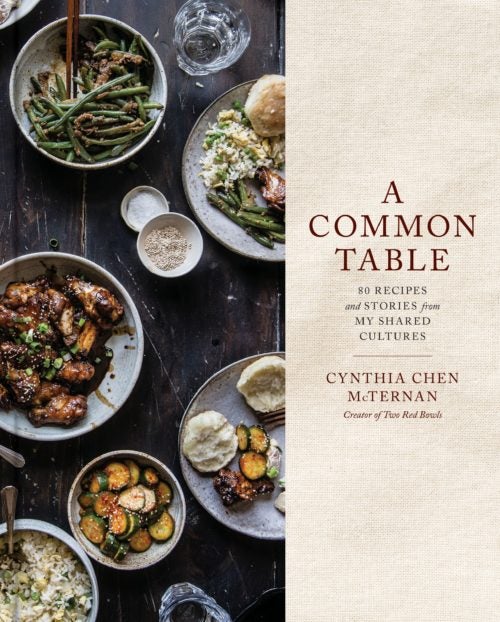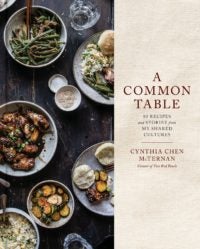



















French toast is a perennial favorite of mine when it comes to indulgent weekend breakfasts. I can never get enough of the play on textures between the custardy innards and the crisp, slightly chewy exterior, or the subtle savory-meets-sweet combination of egg and maple syrup. This particular version is inspired by the Chinese sweet dumpling soup dessert called tangyuan. My favorite tangyuan are the ones stuffed with a nutty black sesame filling that flows out, molten and inky, when you bite into a dumpling. It’s possible that this filling works even better in French toast than in a sweet rice dumpling—the nutty, smoky sweetness and slightly sandy texture is a robust contrast against the eggy, custardy toast. Even as someone who loves French toast in any incarnation, I think it’s one of the best versions I’ve ever had.
Directions
- The night before, or at least 2 hours before baking: In a small saucepan over medium heat, bring the milk just to a boil, 2 to 3 minutes, or heat the milk to a boil in a small microwave-safe bowl in the microwave, about 1 minute. (This scalds the milk to kill any enzymes that might prevent the yeast from doing their thing.) Set aside to cool slightly. If you find a film on the surface of the milk after heating it, just pour the milk through a sieve.
- Next, make the tangzhong: In a small saucepan, whisk together the water and bread flour until no lumps remain. Heat over medium-low, whisking constantly, until the mixture begins to resemble a roux-like gel, about 2 minutes. As soon as lines begin to appear in the mixture when stirred, remove from the heat and transfer to a small, clean bowl. Let cool to room temperature.
- Prepare the dough: When the milk is just warm but no longer hot, about 100°F to 110°F, sprinkle the active dry yeast on top and let sit until foamy, 5 to 10 minutes. (See Notes if using instant yeast.) If the milk-yeast mixture does not foam, you may want to start over to make sure your yeast is active.
- Meanwhile, in a large bowl, whisk together the flour, sugar, milk powder (if using), and salt. If not using a scale, take care to use the spoon-and-sweep method for measuring your flour, since too much flour can make the bread dense.
- Once the yeast has foamed, add the tangzhong and the egg to the milk-yeast mixture, and whisk until well combined.
- Make a well in the flour mixture and pour in the wet ingredients. Stir with a wooden spoon or silicone spatula until the mixture forms a loose, shaggy dough, then switch to using your hands. The dough should be sticky and soft but not gloppy, and should hold its form. Knead until the dough forms a semi-smooth ball, about 5 minutes. If it sticks too much as you knead, sprinkle flour over your hands and the dough as needed (I usually use 2 to 3 tablespoons)
- Add the butter to the dough, 1 tablespoon at a time, kneading after each addition. Add the second tablespoon of butter only after the first has been evenly incorporated. The kneading will be slippery and messy at this point, but just keep kneading and it should eventually form a soft and pliable dough that’s easy to work with. Knead until the dough becomes smooth and elastic, an additional 4 to 5 minutes.
- Place the dough in a large bowl with plenty of room (no need to grease) and cover with plastic wrap or a damp dish towel. Let rise in the refrigerator overnight until well doubled, at least 8 hours. (Alternatively, you can let it rise at room temperature for 2 hours or so, until well doubled. I prefer a longer rise, to give the flavor time to develop and to split up the labor. The dough should be fine for up to 24 hours.)
- The next day, at least 1 hour before baking: Shape the loaf as desired, then let rise a second time, this time until the dough bounces back very slowly when pressed with a fingertip, but an indent remains visible, about 1 hour. To shape the bread in the “humped” shape typical of Hokkaido milk bread, divide the bread into 4 equal pieces. Roll each piece into a long oval. Fold the oval lengthwise into thirds, to form a long, skinny rectangle. Roll the rectangle up into a short, wide roll. Repeat with the remaining 3 pieces, then place the rolls into the pan, swirls facing out to the sides. For a regular sandwich loaf–style bread, roll the dough out into an 8-inch square, or thereabouts. Roll the square up like you’re making cinnamon rolls, then place it into the loaf pan with the seam down.
- Just before the dough is done rising: Preheat the oven to 350°F and line a tall 9-by-5-inch loaf pan (I like to use a Pullman pan) with parchment paper. Brush the dough with egg wash if desired, then bake, uncovered, for 30 to 40 minutes, until golden-brown on top and an instant-read thermometer inserted into the center reads 200°F. Enjoy!
- In a small, dry skillet, toast the black sesame seeds over medium heat until a few seeds jump in the pan and they start to smell toasty (but not burnt!), 2 to 3 minutes. In a food processor or blender, combine the sesame seeds and sugar and process until very fine and sandy, about 2 minutes. Reserve 2 tablespoons of the sesame-sugar mixture, then add the diced butter to the remaining mixture and blend again until a wet paste forms, 1 to 2 minutes.
- In a large, shallow bowl, whisk together the eggs, vanilla (if using), and 1 tablespoon of the reserved sesame-sugar mixture until thoroughly combined. Add the milk and whisk again to blend. Cut each slice of bread nearly in half, leaving a “hinge” at the end. Drop generous dollops of the black sesame filling into the center of each slice and use the hinge to close the two halves of the slice around the filling.
- In a large nonstick or cast-iron skillet, heat 1 tablespoon of butter or oil over medium until the butter has melted or the oil is shimmering. Place 2 slices of bread in the egg mixture until one side is soaked in egg, then flip and let the other side soak. Add both slices to the skillet and cook, swirling the pan occasionally, until browned on the bottom, about 3 minutes. Flip the slices and cook, swirling the pan occasionally, until the other side is browned, about 3 more minutes. Transfer to a plate and repeat with the remaining tablespoon of butter or oil and the remaining slices of bread. Serve with sweetened condensed milk and an extra sprinkling of black sesame sugar over top, and enjoy immediately.
Reprinted from A Common Table. Copyright © 2018 Cynthia Chen McTernan. Published by Rodale, an imprint of Penguin Random House LLC. Photography by Cynthia Chen McTernan.

